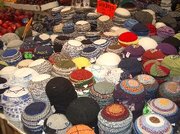Yarmulke
|
|
| This article is part of the hats and headgear series: |
| Overview of headgear |
| Hats; Bonnets; Caps |
| Hoods; Helmets; Wigs |
| Masks; Veils; Scarves |
| Tiaras; Papal tiaras |
| Crowns; Types of crowns |
| List of hats and headgear |
A yarmulke (also yarmulka, yarmelke) (Yiddish יאַרמלקע yarmlke) or Kippah (Hebrew "כִּפָּה" kippāh, plural kippot) is a thin, usually slightly rounded cloth cap worn by Jews. Yarmulkes range in size from 4" in diameter to 9 1/2" (100 mm to 240 mm) or larger.
| Contents |
Traditions
Traditionally the yarmulke was worn only by men (women covered their heads more completely with scarves, hats, or wigs), but in modern times the push for equality between the sexes in the practice of Judaism has led some non-Orthodox women to also wear yarmulkes. Some Jews wear yarmulkes only while praying, making blessings, or studying Jewish religious texts; more traditional Jews wear yarmulkes the entire day, making sure not to walk more than four cubits (about 2 metres) without a head covering, especially outside.
Often, the color and fabric of the yarmulke can be a sign of adherence to a specific religious movement. The Israeli Religious Zionist community is often referred to by the name kippot srugot (Hebrew כיפות סרוגות), literally "woven yarmulkes," though they are typically crocheted. Similarly, some Haredi sects are referred to by the name kipot shkhorot (Hebrew כיפות שחורות), literally "black yarmulkes". Kippot shkhorot are usually sewn of black fabric and often made larger than kippot srugot.
Etymology
The etymology of yarmulke is unclear. Some linguists (e.g. Max Vasmer) maintain that the Yiddish word is derived (via Ukrainian or Polish) from the Turkic yağmurluk, meaning 'rainwear'. Other linguists (e.g. Herbert Zeiden) regard this hypothesis as untenable but still believe a Turkic origin is likely, suggesting that the first part of the word may come from yarim, a Turkic adjective meaning 'half', while the second part may come from qap, a Turkic word for 'cap', 'shell', 'enclosure', or 'container'.
Traditionally, yarmulke is considered to have originated from the Aramaic phrase "yarei mei-elokah" (in awe of the Lord), or perhaps, "yira malkah" (fear of the King), in keeping with the principle that the yarmulke is supposed to reflect someone's fear of heaven.
In Hebrew, the word kippah means dome.
Purpose
Rav_Sloveitchik.bmp
The sources for wearing a yarmulke are found in the Talmud. In tractate Shabbat 156b it states Cover your head in order that the fear of heaven may be upon you. As well, in tractate Kiddushin 32a it states Rabbi Huna the son of Rabbi Joshua never walked 4 cubits (2 meters) with his head uncovered. He explained: "Because the Divine Presence (Shekhina) is always over my head." While there is a minority opinion that wearing a yarmulke is a Torah commandment, most halakhic decisors agree that it is merely a custom, though one that has taken on the force of law. This is codified in the Shulkhan Arukh Orach Chayim 2:6.
Reasons given for wearing a kippah today include:
- recognition that God is "above" us,
- "acceptance" of the 613 mitzvot (commandments),
- "identification" with the Jewish people.
Some have a custom of wearing two head coverings, typically a yarmulke and a hat on top, for Kabbalistic reasons; the two coverings correspond to two levels of intellect, or two levels in the fear of God. The High Priest of the Temple in Jerusalem, the Kohen Gadol, also used to wear a woolen kippa under his priestly hat.(B.T. Chulin 138a)[1] (http://www.chabadtalk.com/go/ph/ph-7.htm)
External links
- Aish HaTorah's Ask the Rabbi on head covering (http://www.aish.com/rabbi/ATR_browse.asp?s=Yarmulke&f=tqak&offset=1)
- Ohr Someyach's Ask the Rabbi on head covering (http://ohr.edu/ask/ask221.htm#Q3)
- The Skullcap - A brief treatise on the significance of covering one's head with a Kipah (http://www.chabad.org/library/article.asp?AID=110370)
- Chabad-Lubavitch Laws of head covering (http://www.chabadtalk.com/go/ph/ph-7.htm)
- The Jewish Encyclopedia on Head-Dress (http://www.jewishencyclopedia.com/view.jsp?artid=465&letter=H)

